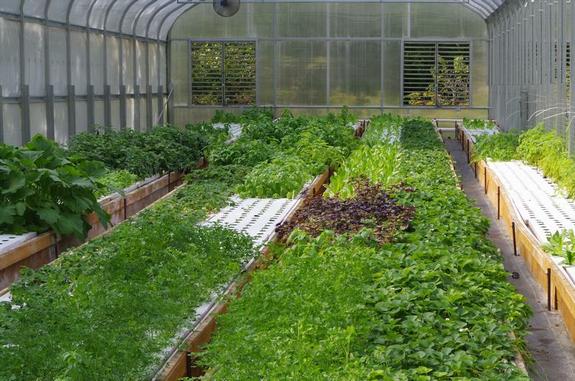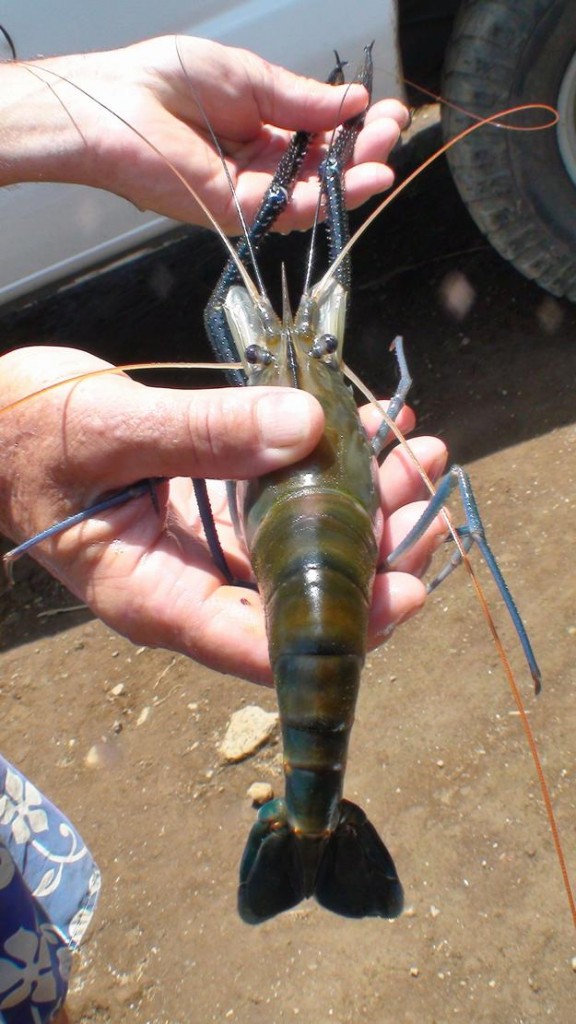Hydroponics Or Aquaponics?
There’s lots of information available about hydroponics. It’s been around for years, some say going back to the “Hanging Gardens” of Babylon. A lot of that is provided by people selling hydroponic systems, just as a lot of the information available about aquaponics is provided by people selling aquaponic systems. The information in both of these cases may be incomplete or inaccurate, because it is designed to get you to buy their systems.
We’ve done our best to give you a balanced and accurate view of aquaponics and hydroponics with this article, so you can decide which fits your needs the best. We don’t sell hydroponics systems or aquaponics systems, and as a result, we are free to publish accurate information rather than information that benefits just us.
(Below) A 512 square foot Family aquaponics system in a greenhouse; it grows vegetables which have incredible flavor when compared to vegetables from hydroponics systems.
Hydroponics and aquaponics both use many of the same methods: deepwater raft culture (what we use and recommend), NFT, or Nutrient Film Technology, media beds with recirculating nutrient solution, and dutch bucket systems with one-way fertigation. However, there are some well-known differences that will help you decide which is best for you.
General Features of Hydroponics Systems:
- Hydroponics systems use chemical fertilizers and additives to grow the vegetables with; most of these are synthesized from oil, so their price and availability is tied directly to the price of oil.
- Hydroponics operators often have to dump their nutrient solutions, sterilize, and refill to discourage disease in their hydroponics systems; this is because hydroponics systems are sterile, just as a hospital is sterile. And in the same way you can get infections in a hospital that are completely resistant to antibiotics (they actually develop there, but that’s another story), there is no natural subsystem in a hydroponics system that controls and eliminates disease. When you refill, you not only have to buy new water, but also pay for a complete charge of chemical fertilizer. You also lose production from the system while it is being sterilized, refilled, and replanted with little baby sprouts.
- When a hydroponics operator dumps the nutrient solution we just mentioned, they have to deal with wastewater regulations when disposing of that water, which can be expensive.
- When hydroponics operators do get plant diseases or have problems with insect pests, they primarily spray conventional pest control chemicals. This class of chemicals is known as organophosphates; they work because they are extremely toxic to the bugs. And to us people.
- Everyone “knows” what hydroponic produce tastes like: like water. We’ve all had the experience of buying beautiful hydroponic lettuces or tomatoes in the store and finding they have little or no flavor; they taste just like the water they are grown in. A very few hydroponic operators use additives called “micro-nutrients” to give their produce more flavor; but even hydroponic produce grown with micro-nutrients doesn’t come near the flavor of conventional produce, let alone organic produce. My wife and I have both purchased hydroponic tomatoes and lettuce. Once. This “feature” does not encourage return customers.
- Fewer people seem to recognize what a short shelf life most hydroponic produce has. This is a serious drawback if you’re planning on doing commercial hydroponics, for this is one of the quality indicators your buyers will be looking for.
(Below) A 64 square foot Micro aquaponics system outdoors with an incredible variety of organic produce.

General Features of Aquaponics Systems:
- Aquaponics systems only require fish food, and an occasional addition of organic iron and calcium carbonate (oyster shell, for the calcium). No chemical fertilizers or additives are ever used; most of these would harm or kill your fish. Your fish are your “fertilizer generator”; you want to take good care of them. You can make your own fish food, so its price and availability is not tied directly to the price of oil.
- Aquaponics operators never have to dump their nutrient solutions, sterilize, and refill to discourage disease in their aquaponics systems. This is because aquaponics systems are living ecosystems, just as a river or a lake is a living ecosystem. And in the same way that lakes and rivers (when left alone!) tend to stay healthy, your aquaponics system tends to stay healthy, and the vegetables and fish in it almost never develop diseases.
- You never have to dump and refill, you never have to buy new water, and never pay for a complete charge of chemicals. You never lose production from the system while it is being sterilized, refilled, and replanted with little baby sprouts. All these nevers save you money.
- If you ever have an insect pest to deal with, you can control it with a wide range of USDA organically-certified sprays and methods; and as a result, the produce from an aquaponics system is organic.
- In fact, the produce from an aquaponics system is guaranteed organic, because if the grower uses anything toxic on the plants (even including several types of organic sprays that we don’t use), it will eventually get back to the fish and kill them. The fish are the “canary in the coal mine”. Their good health guarantees that the produce from an aquaponics system is safe and clean for people to eat.
- Several organic soil farmers we know have told us our produce is the best-tasting they’ve ever had, including their own. This was difficult for them to admit, as “organic in soil” is supposed to be the best. We know it’s the best-tasting produce we’ve ever eaten. This feature encourages return customers, and they tell all their friends, and pretty soon you’re selling all you can grow just on your block.
- We had no idea what kind of shelf life aquaponic produce had when we began our farm; our first harvest went into one-pound dated plastic bags, and went into the fridge as our first shelf life test. One of these bags went to town (to show the bank president what her loan money had funded), and was out of the refrigerator for an hour and a half. Later, this same bag spent two hours unrefrigerated on the kitchen counter. Then we forgot about the bag. I made myself lunch some time later; by this time we had lots of bags of lettuce in our big fridge. I grabbed a bag at random to put lettuce on my sandwich; I noticed that this bag had a little bit of “green slimy” on the leaves towards the bottom of the bag, so I simply took a handful of lettuce off the top. While I was eating my sandwich, I idly glanced at the date on the bag: I was eating 2-1/2 month-old lettuce! Aquaponic produce easily has a two to three week shelf life in the fridge. This is a serious benefit, and will blow your buyers away; they have never seen produce with shelf life like this!
- Almost forgot! Aquaponics systems grow fish, and prawns, and other stuff too (we’ve grown freshwater limpets in ours!), that hydroponics systems do not and can not grow.


